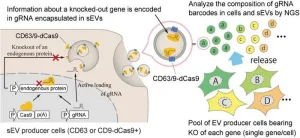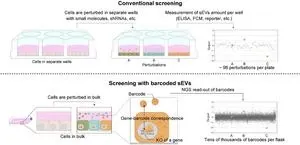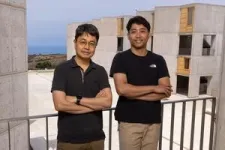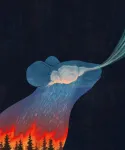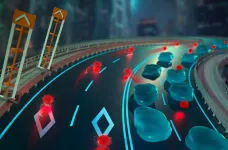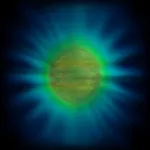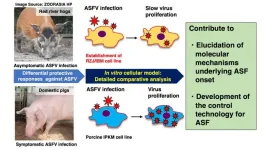(Press-News.org) Cell-to-cell communication through nanosized particles, working as messengers and carriers, can now be analyzed in a whole new way, thanks to a new method involving CRISPR gene-editing technology. The particles, known as small extracellular vesicles (sEVs), play an important role in the spread of disease and as potential drug carriers. The newly developed system, named CIBER, enables thousands of genes to be studied at once, by labeling sEVs with a kind of RNA “barcode.” With this, researchers hope to find what factors are involved in sEV release from host cells. This will help advance our understanding of basic sEV biology and may aid in the development of new treatments for diseases, such as cancer.
Your body “talks” in more ways than one. Your cells communicate with each other, enabling your different parts to function as one team. However, there are still many mysteries surrounding this process. Extracellular vesicles (EVs), small particles released by cells, were previously thought to be useless waste. However, in recent decades they have been dramatically relabeled as very important particles (VIPs), due to their association with various diseases, including cancer, neurodegenerative diseases and age-related diseases.
Small EVs have been found to play a key role in cell-to-cell communication. Depending on what “cargo” they carry from their host cell (which can include RNA, proteins and lipids), sEVs can help maintain normal tissue functions or can further the spread of diseases. Because of this, researchers are interested in how sEVs form and are released. However, separating sEVs from other molecules and identifying the factors which lead to their release is both difficult and time-consuming with conventional methods. So, a team in Japan has developed a new technique.
“We have established a new high-throughput screening platform named CIBER (CRISPR-assisted individually barcoded sEV-based release regulator). This system allows a single experimenter to implement a genome-wide screening of sEV release regulators within several weeks to a couple of months, which is superefficient compared to the conventional methods,” explained Associate Professor Ryosuke Kojima from the Graduate School of Medicine at the University of Tokyo. “CIBER should be a valuable tool for detailed studies on the creation, release and diversity of sEVs.”
The CIBER system works by using CRISPR-guide RNA (gRNA) to knock out (incapacitate) a specific gene in each cell, which in turn is barcoded into the sEVs the cell releases. This enables the researchers to track and estimate the amount of sEVs released by the host cell. Current methods to study factors involved in sEV release involve separating cells into wells, disturbing the expression and activity of a gene in the cells in each well, and then measuring how that impacts the amount of sEVs released. However, with the CIBER system, thousands of cells with different genes knocked out can be studied together in one pool. Thanks to this, researchers can study the various complex factors involved in sEV release simultaneously, as well as estimate the amount of sEVs and different types (subpopulations) released from each cell.
“In the future, CIBER screening could be used to identify the therapeutic target of sEV releases or enhance the production of sEVs for therapeutic use, such as for cancer,” said Kojima. “Barcoded sEVs could also be used to estimate cell population dynamics without destroying cells, and tracing the fate of barcoded sEVs can help us better understand sEV biology. We believe that CIBER screening has great potential.”
##########
Paper
Koki Kunitake, Tadahaya Mizuno, Kazuki Hattori, Chitose Oneyama, Mako Kamiya, Sadao Ota, Yasuteru Urano, Ryosuke Kojima. Barcoding of small extracellular vesicles with CRISPR-gRNA enables comprehensive, subpopulation- specific analysis of their biogenesis/release regulators. Nature Communications. November 19th, 2024. DOI: 10.1038/s41467-024-53736-x, URL: https://www.nature.com/articles/s41467-024-53736-x
Funding:
This work was supported by the JST FOREST (Project Number: JPMJFR214N), JST PRESTO (Project Number: JPMJPR17H5), JST CREST (Project Numbers: JPMJCR19H1, JPMJCR23B7), Human Frontier Science Program (Project Number: CDA-00008/2019-C), Grant-in-Aid for Transformative Research Areas (Project Number: 24H00868), and ATI Research Grant.
Conflicts of interest:
K.K., Y.U., R.K. have filed a patent for the screening system of sEV release regulators (WO2021095842 (published), application by the University of Tokyo). The other authors report no competing interests.
Useful Links:
Graduate School of Medicine: https://www.m.u-tokyo.ac.jp/english/
Laboratory of Chemical Biology and Molecular Imaging: https://cbmi.m.u-tokyo.ac.jp/research
Research Contact:
Associate Professor Ryosuke Kojima
Graduate School of Medicine,
The University of Tokyo, Tokyo, 113-0033 Japan
Email: kojima@m.u-tokyo.ac.jp
Press contact:
Mrs. Nicola Burghall (she/her)
Public Relations Group, The University of Tokyo,
7-3-1 Hongo, Bunkyo-ku, Tokyo 113-8654, Japan
press-releases.adm@gs.mail.u-tokyo.ac.jp
About the University of Tokyo
The University of Tokyo is Japan’s leading university and one of the world’s top research universities. The vast research output of some 6,000 researchers is published in the world’s top journals across the arts and sciences. Our vibrant student body of around 15,000 undergraduate and 15,000 graduate students includes over 4,000 international students. Find out more at www.u-tokyo.ac.jp/en/ or follow us on X (formerly Twitter) at @UTokyo_News_en.
END
Labeling cell particles with barcodes
New CRISPR-based system could help us better understand cell-to-cell communication with unprecedented efficiency
2024-11-19
ELSE PRESS RELEASES FROM THIS DATE:
Groundwater pumping drives rapid sinking in California
2024-11-19
A new study shows land in California’s San Joaquin Valley has been sinking at record-breaking rates over the last two decades as groundwater extraction has outpaced natural recharge.
The researchers found that the average rate of sinking for the entire valley reached nearly an inch per year between 2006 and 2022.
Researchers and water managers have known that sinking, technically termed “subsidence,” was occurring over the past 20 years. But the true impact was not fully appreciated because the total subsidence had not been quantified. This was in part due to a gap in data. Satellite radar systems, which provide the most precise measure of elevation changes, ...
Neuroscientists discover how the brain slows anxious breathing
2024-11-19
LA JOLLA (November 19, 2024)—Deep breath in, slow breath out… Isn’t it odd that we can self-soothe by slowing down our breathing? Humans have long used slow breathing to regulate their emotions, and practices like yoga and mindfulness have even popularized formal techniques like box breathing. Still, there has been little scientific understanding of how the brain consciously controls our breathing and whether this actually has a direct effect on our anxiety and emotional state.
Neuroscientists ...
New ion speed record holds potential for faster battery charging, biosensing
2024-11-19
PULLMAN, Wash. – A speed record has been broken using nanoscience, which could lead to a host of new advances, including improved battery charging, biosensing, soft robotics and neuromorphic computing.
Scientists at Washington State University and Lawrence Berkeley National Laboratory have discovered a way to make ions move more than ten times faster in mixed organic ion-electronic conductors. These conductors combine the advantages of the ion signaling used by many biological systems, including the human body, with the electron signaling used by computers.
The new development, detailed in the journal ...
Haut.AI explores the potential of AI-enhanced fluorescence photography for non-invasive skin diagnostics
2024-11-19
Tallinn, Estonia – 19th November 2024, 10 AM CET – Haut.AI, a pioneering artificial intelligence (AI) company for skincare and beauty applications, has published an exciting scientific review—one that explores state-of-the-art developments in skin fluorescence photography and its applications, focusing on combining it with AI algorithms for non-invasive skin diagnostics. The study highlights the power of AI to enhance skin fluorescence photography, allowing early, non-invasive detection of skin conditions. This approach allows skincare experts to diagnose underlying issues ...
7-year study reveals plastic fragments from all over the globe are rising rapidly in the North Pacific Garbage Patch
2024-11-19
A study published today in IOP Publishing’s journal Environmental Research Letters reveals that centimetre-sized plastic fragments are increasing much faster than larger floating plastics in the North Pacific Garbage Patch [NPGP], threatening the local ecosystem and potentially the global carbon cycle.
The research, which draws from not-for-profit The Ocean Cleanup’s systematic surveys of the NPGP between 2015 and 2022, found an unexpected rise in mass concentration of plastic fragments that are ...
New theory reveals the shape of a single photon
2024-11-19
A new theory, that explains how light and matter interact at the quantum level has enabled researchers to define for the first time the precise shape of a single photon.
Research at the University of Birmingham, published in Physical Review Letters, explores the nature of photons (individual particles of light) in unprecedented detail to show how they are emitted by atoms or molecules and shaped by their environment.
The nature of this interaction leads to infinite possibilities for light to exist and propagate, or travel, through its surrounding environment. This limitless ...
We could soon use AI to detect brain tumors
2024-11-19
A new paper in Biology Methods and Protocols, published by Oxford University Press, shows that scientists can train artificial intelligence models to distinguish brain tumors from healthy tissue. AI models can already find brain tumors in MRI images almost as well as a human radiologist.
Researchers have made sustained progress in artificial intelligence (AI) for use in medicine. AI is particularly promising in radiology, where waiting for technicians to process medical images can delay patient treatment. Convolutional neural networks are powerful tools that allow researchers to train AI models on large image datasets to recognize ...
TAMEST recognizes Lyda Hill and Lyda Hill Philanthropies with Kay Bailey Hutchison Distinguished Service Award
2024-11-19
TAMEST is pleased to announce Lyda Hill and Lyda Hill Philanthropies as the recipients of the Kay Bailey Hutchison Distinguished Service Award.
TAMEST is recognizing Lyda Hill and her team for empowering and enabling groundbreaking research in science and nature that profoundly impacts society. Lyda Hill, a successful businesswoman and world-renowned philanthropist, believes science can solve many of the world’s most challenging issues and has chosen to donate all of her estate to philanthropy and scientific research.
Aligned with this mission, Lyda Hill is committed to advancing science and public ...
Establishment of an immortalized red river hog blood-derived macrophage cell line
2024-11-19
Red river hogs (RRHs) (Potamochoerus porcus), a wild species of Suidae living in Africa, have grabbed much attention as an animal that harbors African swine fever virus (ASFV) as natural hosts. When ASFV infects domestic pigs and wild boars, it proliferates within macrophages, a type of immune cells, and infected pigs rapidly die suffering from symptoms such as fever and hemorrhage. On the other hand, ASFV infection in RRHs is asymptomatic and does not cause death, suggesting that RRH macrophages may have a protective mechanism against ASFV infection.
In vitro cell cultures of porcine macrophages are generally ...
Neural networks: You might not need to buy every ticket to win the lottery
2024-11-19
The more lottery tickets you buy, the higher your chances of winning, but spending more than you win is obviously not a wise strategy. Something similar happens in AI powered by deep learning: we know that the larger a neural network is (i.e., the more parameters it has), the better it can learn the task we set for it. However, the strategy of making it infinitely large during training is not only impossible but also extremely inefficient. Scientists have tried to imitate the way biological brains learn, which is highly resource-efficient, by providing machines with a gradual training process that starts with ...
LAST 30 PRESS RELEASES:
This new understanding of T cell receptors may improve cancer immunotherapies
A new fossil face sheds light on early migrations of ancient human ancestor
A new immunotherapy approach could work for many types of cancer
A new way to diagnose deadly lung infections and save lives
40 percent of MRI signals do not correspond to actual brain activity
How brain-inspired algorithms could drive down AI energy costs
Gum disease may be linked to plaque buildup in arteries, higher risk of major CVD events
Contrails are a major driver of aviation’s climate impact
Structure of dopamine-releasing neurons relates to the type of circuits they form for smell-processing
Reducing social isolation protects the brain in later life
Keeping the heart healthy increases longevity even after cancer
Young adults commonly mix cannabis with nicotine and tobacco
Comprehensive review illuminates tau protein's dual nature in brain health, disease, and emerging psychiatric connections
Book prepares K-12 leaders for the next public health crisis
Storms in the Southern Ocean mitigates global warming
Seals on the move: Research reveals key data for offshore development and international ecology
Sports injuries sustained during your period might be more severe
World's first successful 2 Tbit/s free-space optical communication using small optical terminals mountable on satellites and HAPS
Can intimate relationships affect your heart? New study says ‘yes’
Scalable and healable gradient textiles for multi‑scenario radiative cooling via bicomponent blow spinning
Research shows informed traders never let a good climate crisis go to waste
Intelligent XGBoost framework enhances asphalt pavement skid resistance assessment
Dual-function biomaterials for postoperative osteosarcoma: Tumor suppression and bone regeneration
New framework reveals where transport emissions concentrate in Singapore
NTP-enhanced lattice oxygen activation in Ce-Co catalysts for low-temperature soot combustion
Synergistic interface engineering in Cu-Zn-Ce catalysts for efficient CO2 hydrogenation to methanol
COVID-19 leaves a lasting mark on the human brain
Scientists use ultrasound to soften and treat cancer tumors without damaging healthy tissue
Community swimming program for Black youth boosts skills, sense of belonging, study finds
Specific depressive symptoms in midlife linked to increased dementia risk
[Press-News.org] Labeling cell particles with barcodesNew CRISPR-based system could help us better understand cell-to-cell communication with unprecedented efficiency
